Deck 16: Wonder and Woe: the Rise of Industrial America, 1865-1900
Question
Question
Question
Question
Question
Question
Question
Question
Question
Question
Question
Question
Question
Question
Question
Question
Question
Question
Question
Question
Question
Question
Question
Question
Question
Question
Question
Question
Question
Question
Question
Question
Question
Question
Question
Question
Question
Question
Question
Question
Question
Question
Question
Question
Question
Question
Question
Question
Question
Question

Unlock Deck
Sign up to unlock the cards in this deck!
Unlock Deck
Unlock Deck
1/50
Play
Full screen (f)
Deck 16: Wonder and Woe: the Rise of Industrial America, 1865-1900
1
Which American literary figure celebrated the railroad as "the modern emblem of motion and power-the pulse of the continent"?
A) Mark Twain
B) Walt Whitman
C) Ralph Waldo Emerson
D) Henry David Thoreau
A) Mark Twain
B) Walt Whitman
C) Ralph Waldo Emerson
D) Henry David Thoreau
Walt Whitman
2
Frank W. Woolworth's stores were known as .
A) emporiums
B) "five and dime" stores
C) shopping resorts
D) grand depots
A) emporiums
B) "five and dime" stores
C) shopping resorts
D) grand depots
"five and dime" stores
3
What were the two most significant sources for cheap labor that allowed the United States to rapidly industrialize between 1860 and 1900?
A) immigrants and American-born workers moving from rural areas
B) women and children
C) African Americans and Chinese laborers
D) immigrants and African Americans
A) immigrants and American-born workers moving from rural areas
B) women and children
C) African Americans and Chinese laborers
D) immigrants and African Americans
immigrants and American-born workers moving from rural areas
4
The first big business in the United States was the industry.
A) textile
B) steel
C) coal
D) railroad
A) textile
B) steel
C) coal
D) railroad

Unlock Deck
Unlock for access to all 50 flashcards in this deck.
Unlock Deck
k this deck
5
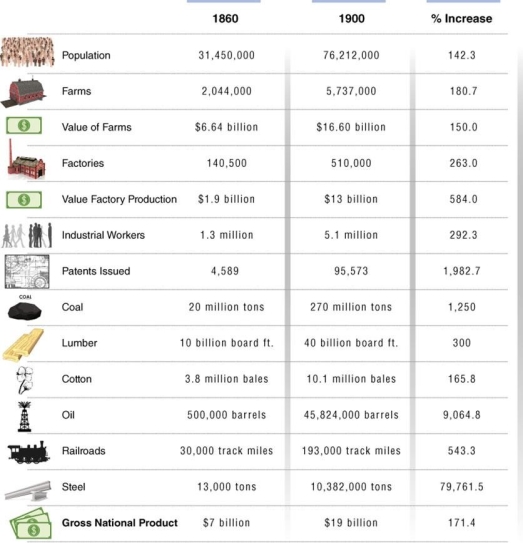
Based on this table, what factor was most responsible for the large spike in the gross national product between 1860 and 1900?
A) agricultural production
B) industrialization
C) railroads
D) population growth

Unlock Deck
Unlock for access to all 50 flashcards in this deck.
Unlock Deck
k this deck
6
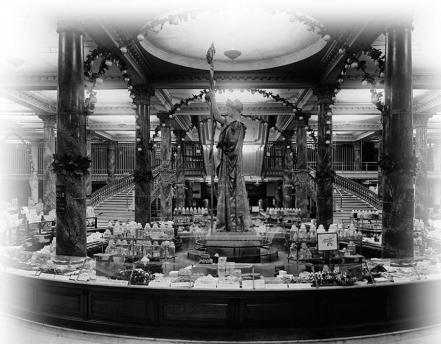
As shown in this 1896 opening day photograph of the Siegel-Cooper Department Store in New York City, why did retailers choose to decorate their stores with such lavish interiors?
A) to emphasize the importance of the advertising business in shopping
B) to keep out undesirable customers who could not afford to shop there
C) to impress customers with their accumulation of wealth
D) to attract customers by providing them with pleasurable shopping experiences

Unlock Deck
Unlock for access to all 50 flashcards in this deck.
Unlock Deck
k this deck
7
Why did advertisements increasingly need to be eye-catching and memorable in the late nineteenth century?
A) to satisfy the requirements of newspaper and magazine editors
B) to entertain demanding shoppers
C) to stand out among the growing number of other advertisements
D) to distract discerning customers from misleading and exaggerated claims
A) to satisfy the requirements of newspaper and magazine editors
B) to entertain demanding shoppers
C) to stand out among the growing number of other advertisements
D) to distract discerning customers from misleading and exaggerated claims

Unlock Deck
Unlock for access to all 50 flashcards in this deck.
Unlock Deck
k this deck
8

How does this image depict the economic benefits brought to the nation by the railroad's standard gauge system?
A) It helped the South gain readmission to the Union during Reconstruction.
B) It led to the creation of four standardized time zones.
C) It was responsible for the completion of a transcontinental railroad that spanned the nation.
D) It brought greater unity between the less-developed South and the rapidly industrializing North.

Unlock Deck
Unlock for access to all 50 flashcards in this deck.
Unlock Deck
k this deck
9
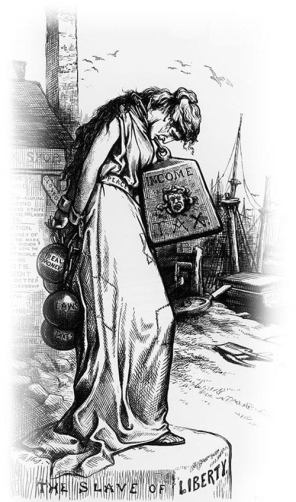
Cartoonist Thomas Nast's 1878 illustration Peace with a War Measure calls for support of
)
A) laissez-faire policies toward business
B) government-imposed burdens like income taxes and "ideal money"
C) legislation to curb cutthroat business policies
D) laws to regulate the hours of work, safety conditions, and wages

Unlock Deck
Unlock for access to all 50 flashcards in this deck.
Unlock Deck
k this deck
10
The central belief behind laissez-faire philosophy in the relationship between government and business is that .
A) government should provide generous financial support to bolster business
B) government should impose no restraints on business
C) business should share its profits with the government
D) business should receive profits generated from high federal tariffs
A) government should provide generous financial support to bolster business
B) government should impose no restraints on business
C) business should share its profits with the government
D) business should receive profits generated from high federal tariffs

Unlock Deck
Unlock for access to all 50 flashcards in this deck.
Unlock Deck
k this deck
11
Andrew Carnegie's success in the steel industry can best be attributed to .
A) cost control and cutthroat business practices
B) the use of skilled metalworkers and investment in the latest technology
C) horizontal integration and sympathy to workers' conditions
D) wise investments and philanthropy
A) cost control and cutthroat business practices
B) the use of skilled metalworkers and investment in the latest technology
C) horizontal integration and sympathy to workers' conditions
D) wise investments and philanthropy

Unlock Deck
Unlock for access to all 50 flashcards in this deck.
Unlock Deck
k this deck
12
Two cases, Wabash, St. Louis & Pacific Railway Co. v. Illinois and Santa Clara County v. Southern Pacific Railroad, demonstrated that the Supreme Court in 1886 was primarily
A) conservative and supported big business
B) conservative but opposed big business
C) progressive and supported labor unions
D) progressive but opposed labor unions
A) conservative and supported big business
B) conservative but opposed big business
C) progressive and supported labor unions
D) progressive but opposed labor unions

Unlock Deck
Unlock for access to all 50 flashcards in this deck.
Unlock Deck
k this deck
13
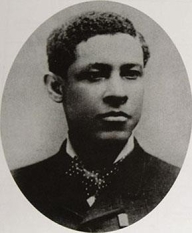
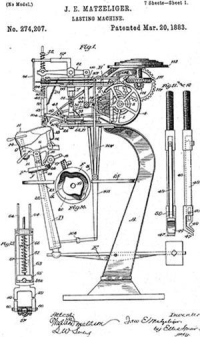
How did Jan Matzeliger's complex lasting machine permanently change the shoe production industry?
A) Skilled shoe laborers received significant wage increases.
B) Skilled laborers instead of unskilled workers were now needed to produce shoes.
C) Skilled shoe laborers were replaced with unskilled laborers.
D) Shoe production became more expensive since the upper portions of shoes had to be attached to the soles by hand.

Unlock Deck
Unlock for access to all 50 flashcards in this deck.
Unlock Deck
k this deck
14
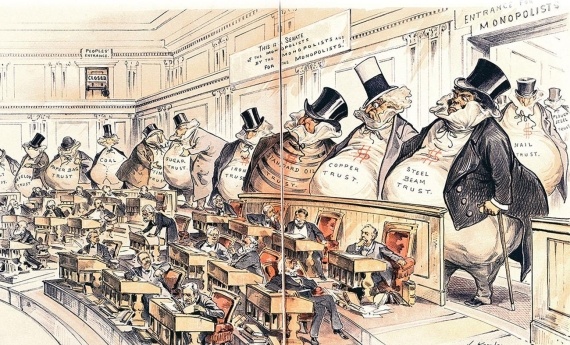
Why does the 1889 cartoon The Bosses of the Senate from Puck magazine imply that the Sherman Anti-Trust Act of 1890 would be a failure?
A) Congress was indifferent to the needs of both business and unions.
B) Congress was in league with big business.
C) Congress would take action when the president would not.
D) Congress worked diligently to protect the people.

Unlock Deck
Unlock for access to all 50 flashcards in this deck.
Unlock Deck
k this deck
15
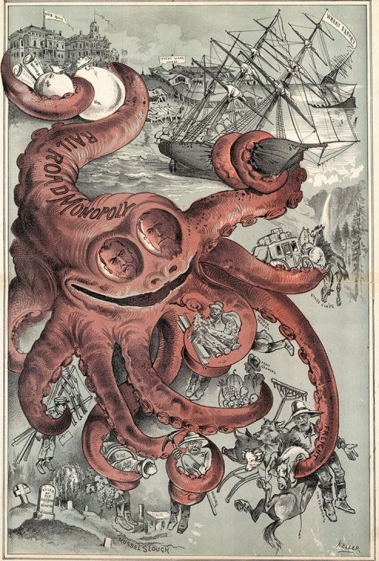
Why did the artist choose to portray the Southern Pacific Railroad's monopoly as an octopus?
A) Its wealthy owners were "captains of industry" who supported the public.
B) It had to be depicted as a multi-armed creature because it helped so many industries.
C) It strangled its rivals in competing industries.
D) It single-handedly destroyed the American maritime industry.

Unlock Deck
Unlock for access to all 50 flashcards in this deck.
Unlock Deck
k this deck
16
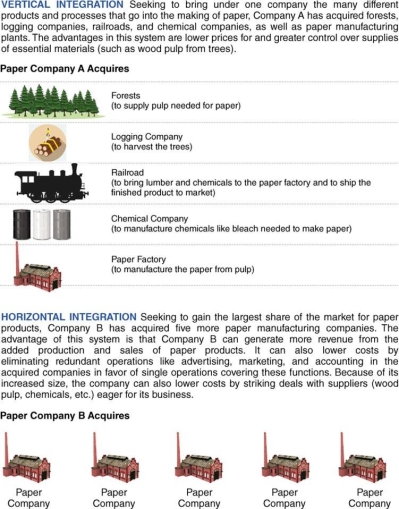
How does this graphic illustrate the difference between vertical integration and horizontal integration?
A) The focus of horizontal integration is on controlling raw materials whereas the focus of vertical integration is on the finished product.
B) Companies employing horizontal integration generally follow fair labor practices whereas those employing vertical integration typically exploit their workers.
C) Vertical integration involves control of all phases of production whereas horizontal integration involves buying out rival companies producing the same product.
D) Vertical integration involves the abuse of conventional ethics whereas horizontal integration is illegal.

Unlock Deck
Unlock for access to all 50 flashcards in this deck.
Unlock Deck
k this deck
17
How did John D. Rockefeller initially expand his interests in Standard Oil?
A) collaboration with labor unions to keep his workers satisfied
B) vertical integration through the purchase of oil fields, railroad cars, and warehouses
C) horizontal integration through the purchase or construction of oil refineries
D) fair competition with rival oil companies
A) collaboration with labor unions to keep his workers satisfied
B) vertical integration through the purchase of oil fields, railroad cars, and warehouses
C) horizontal integration through the purchase or construction of oil refineries
D) fair competition with rival oil companies

Unlock Deck
Unlock for access to all 50 flashcards in this deck.
Unlock Deck
k this deck
18
Which group was the first to successfully curb the power of the railroad through passage of legislation that regulated prices and outlawed unfair business practices?
A) Congress
B) the Knights of Labor
C) skilled workers in the American Federation of Labor
D) farmers in the Grange movement
A) Congress
B) the Knights of Labor
C) skilled workers in the American Federation of Labor
D) farmers in the Grange movement

Unlock Deck
Unlock for access to all 50 flashcards in this deck.
Unlock Deck
k this deck
19
What central theme in American society did artist Robert Koehler explore in The Strike as the United States experienced rapid industrialization in the late nineteenth century?
A) corruption and abusive practices of industrial employers
B) celebration of formidable American industrial power
C) uncertainty rising from tensions between workers and employers
D) dreariness associated with the grim life of industrial workers
A) corruption and abusive practices of industrial employers
B) celebration of formidable American industrial power
C) uncertainty rising from tensions between workers and employers
D) dreariness associated with the grim life of industrial workers

Unlock Deck
Unlock for access to all 50 flashcards in this deck.
Unlock Deck
k this deck
20
The Indianapolis Sentinel's 1883 remarks that "Railroad time…appears…to be the time of the future. And so, people will now have to marry and die by railroad time…The sun is no longer the boss of the job," was the result of .
A) selling railroad stock to raise capital to expand that business
B) the railroad's advantage of using speed to transport people and goods at faster rates
C) the railroad's development of modern, sophisticated management practices
D) standardized rail equipment that allowed easier operation of this industry
A) selling railroad stock to raise capital to expand that business
B) the railroad's advantage of using speed to transport people and goods at faster rates
C) the railroad's development of modern, sophisticated management practices
D) standardized rail equipment that allowed easier operation of this industry

Unlock Deck
Unlock for access to all 50 flashcards in this deck.
Unlock Deck
k this deck
21
How did employers justify the disparity of paying female workers half or less than half of the wages earned by men?
A) Women spent more time at home completing "finishing" work than in the workplace.
B) Women were responsible for more accidents in the workplace than men.
C) Women lacked the education needed to perform many of the unskilled jobs that men did.
D) Women merely worked for extra money, while men worked to support their families.
A) Women spent more time at home completing "finishing" work than in the workplace.
B) Women were responsible for more accidents in the workplace than men.
C) Women lacked the education needed to perform many of the unskilled jobs that men did.
D) Women merely worked for extra money, while men worked to support their families.

Unlock Deck
Unlock for access to all 50 flashcards in this deck.
Unlock Deck
k this deck
22
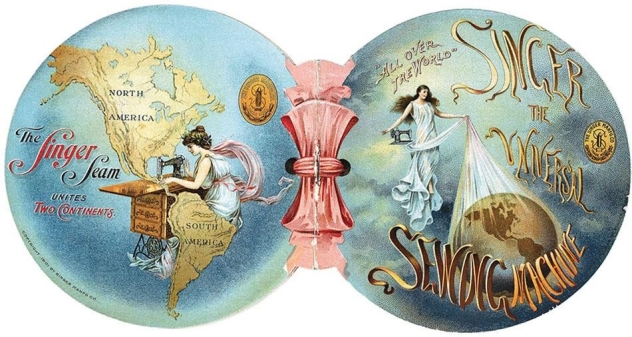
What did this 1890s advertisement by the Singer Sewing Machine Company imply about the economy of the United States during this time period?
A) American companies like Singer were still national corporations.
B) Purchases made by American women required their husbands' approval and money.
C) The United States needed to become an imperial power to obtain raw materials from other regions.
D) American industry had been globalized.

Unlock Deck
Unlock for access to all 50 flashcards in this deck.
Unlock Deck
k this deck
23
How did Montgomery Ward and, later on, Richard W. Sears and Alvah C. Roebuck connect rural Americans with corporate retail?
A) through mail order catalogues
B) by establishing chain stores in small American towns
C) through delivery of retail goods by Wells Fargo wagons
D) by offering money back guarantees and free delivery
A) through mail order catalogues
B) by establishing chain stores in small American towns
C) through delivery of retail goods by Wells Fargo wagons
D) by offering money back guarantees and free delivery

Unlock Deck
Unlock for access to all 50 flashcards in this deck.
Unlock Deck
k this deck
24
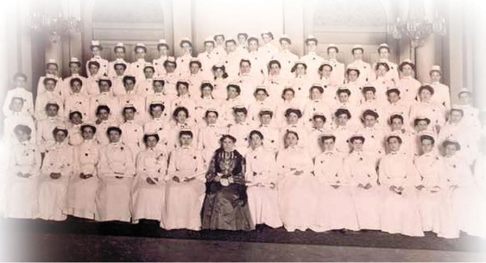
What does this graduation photograph of the Philadelphia School for Nurses, which includes Red Cross founder Clara Barton in the center, imply about the nursing profession in 1900?
A) Women had become leaders in the workforce.
B) Nursing had emerged as a respected profession.
C) Nurses had the right and power to strike against oppressive working conditions.
D) Nursing was an ethnically diverse career in the United States.

Unlock Deck
Unlock for access to all 50 flashcards in this deck.
Unlock Deck
k this deck
25
Which of the following best describes Andrew Carnegie's "Gospel of Wealth"?
A) the belief that industry is a more honorable pursuit than agriculture
B) the belief that wealth is the cure for all evils
C) the belief that those who achieve wealth are likely the most morally deserving
D) the belief that a free market creates opportunities and benefits for all
A) the belief that industry is a more honorable pursuit than agriculture
B) the belief that wealth is the cure for all evils
C) the belief that those who achieve wealth are likely the most morally deserving
D) the belief that a free market creates opportunities and benefits for all

Unlock Deck
Unlock for access to all 50 flashcards in this deck.
Unlock Deck
k this deck
26
What did pro-labor newspaper editor John Swinton imply when he stated that "Capital often triumphs in the conflict with labor…yet capital would be even harsher and more exacting than it is, if it were not for the protest of the strike, and the warning it gives"?
A) Strikes should be enacted even if union members do not fully support them.
B) The federal government should set up an agency to arbitrate labor disputes.
C) Strikes, contrary to popular belief, seldom failed.
D) Poor working conditions would be much worse without unions and strikes.
A) Strikes should be enacted even if union members do not fully support them.
B) The federal government should set up an agency to arbitrate labor disputes.
C) Strikes, contrary to popular belief, seldom failed.
D) Poor working conditions would be much worse without unions and strikes.

Unlock Deck
Unlock for access to all 50 flashcards in this deck.
Unlock Deck
k this deck
27
Why did many of the Irish immigrants in the Workingmen's Benevolent Association (WBA) form the more secretive organization known as the Molly Maguires?
A) to negotiate independently with the owners of the coal mines where they worked
B) to organize strikes which the WBA opposed
C) to seek violent retribution against the foremen and managers of the coal mines
D) to form a union where Irish immigrants would be welcomed
A) to negotiate independently with the owners of the coal mines where they worked
B) to organize strikes which the WBA opposed
C) to seek violent retribution against the foremen and managers of the coal mines
D) to form a union where Irish immigrants would be welcomed

Unlock Deck
Unlock for access to all 50 flashcards in this deck.
Unlock Deck
k this deck
28
What generalization can be made about the $400-$500 annual salaries that wage earners made in the United States during the late nineteenth century?
A) Unskilled workers were guaranteed an affordable minimum wage.
B) Employers within the same industry offered competitive salaries.
C) Wages barely covered basic living expenses.
D) The average American working class family lived a comfortable life.
A) Unskilled workers were guaranteed an affordable minimum wage.
B) Employers within the same industry offered competitive salaries.
C) Wages barely covered basic living expenses.
D) The average American working class family lived a comfortable life.

Unlock Deck
Unlock for access to all 50 flashcards in this deck.
Unlock Deck
k this deck
29
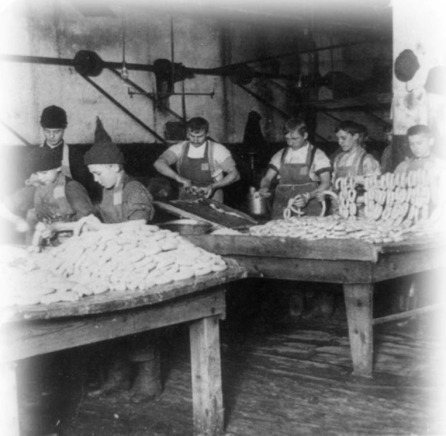
What was the major reason why many children, such as these young boys working in a sausage factory, were hired as laborers by industrial employers?
A) Employers preferred hiring children over minority or female workers.
B) Employers could pay children less than one-half the wages of an adult laborer.
C) Children could be supervised by a parent or relative while working in the factories.
D) Children were able to perform more delicate tasks than what adult workers could do.

Unlock Deck
Unlock for access to all 50 flashcards in this deck.
Unlock Deck
k this deck
30

The 1877 execution of ten alleged Molly Maguires in Pennsylvania was staged as a carefully planned public spectacle and included a priest in order to emphasize the men's .
A) dignity and Irish Catholicism
B) innocence and immigrant backgrounds
C) violence and lawlessness
D) guilt and sinfulness

Unlock Deck
Unlock for access to all 50 flashcards in this deck.
Unlock Deck
k this deck
31
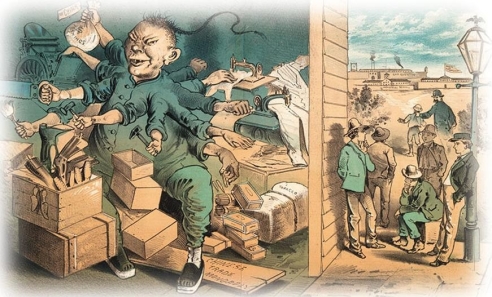
What message did the San Francisco magazine The Wasp send to the public through publication of this satirical cartoon?
A) praise of Chinese workers for possessing multiple jobs skills
B) blame of Chinese workers for taking jobs from Americans through their long hours of work
C) criticism of American workers for idleness and laziness at their jobs
D) condemnation of the Chinese Exclusion Act for its racist beliefs and practices

Unlock Deck
Unlock for access to all 50 flashcards in this deck.
Unlock Deck
k this deck
32
After the Civil War, a leading trend in business was the increase in exports of .
A) agricultural products
B) manufactured goods
C) raw materials
D) oil
A) agricultural products
B) manufactured goods
C) raw materials
D) oil

Unlock Deck
Unlock for access to all 50 flashcards in this deck.
Unlock Deck
k this deck
33
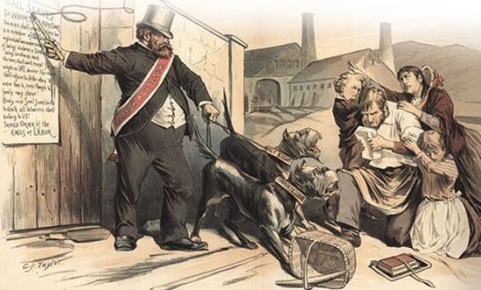
This 1880s image from Puck magazine portrays labor union officials, such as the man with the top hat, as .
A) dedicated educators who kept their workers regularly informed of their rights
B) wealthy businessmen who financially supported their workers while they were on strike
C) tyrants who hurt the interests of workers
D) benevolent leaders who protected their workers

Unlock Deck
Unlock for access to all 50 flashcards in this deck.
Unlock Deck
k this deck
34
What did the editor of Scribner's Monthly imply when he addressed the 1877 "Great Uprising" of railroad workers by stating that unions "…have been despotic toward their own members, oppressive toward the class in whose interest they pretend to have been established, impertinent and intermeddling…"?
A) Unions were illegal, foolish, and un-American.
B) Unions were unsuccessful in organizing because of animosity within their own ranks.
C) Unions were vital organizations that protected workers from exploitation.
D) Unions were responsible for the cuts in workers' wages that led to the "Great Uprising."
A) Unions were illegal, foolish, and un-American.
B) Unions were unsuccessful in organizing because of animosity within their own ranks.
C) Unions were vital organizations that protected workers from exploitation.
D) Unions were responsible for the cuts in workers' wages that led to the "Great Uprising."

Unlock Deck
Unlock for access to all 50 flashcards in this deck.
Unlock Deck
k this deck
35
How did new technology weaken the independence of most skilled workers?
A) They lost their jobs to lower-paid unskilled workers who could operate new machines.
B) They worked longer hours operating the new machinery.
C) They had to produce more goods in shorter amounts of time.
D) They were given more work assignments with no increase in pay.
A) They lost their jobs to lower-paid unskilled workers who could operate new machines.
B) They worked longer hours operating the new machinery.
C) They had to produce more goods in shorter amounts of time.
D) They were given more work assignments with no increase in pay.

Unlock Deck
Unlock for access to all 50 flashcards in this deck.
Unlock Deck
k this deck
36

What was the major reason for the increase in female workers over this thirty-year period as shown on this table?
A) boredom
B) economic necessity
C) the decrease in "piece work" taken in at home
D) a more permissive society where they had opportunities to meet men

Unlock Deck
Unlock for access to all 50 flashcards in this deck.
Unlock Deck
k this deck
37
Once corporate retail reached rural areas of the United States, what evidence showed that Americans now shared a common consumer culture?
A) People spent most of their time off work shopping in department stores.
B) People throughout the country adopted the same fashions.
C) People turned away from new contraptions that were being sold.
D) People relied less on advertising when deciding what retail goods to purchase.
A) People spent most of their time off work shopping in department stores.
B) People throughout the country adopted the same fashions.
C) People turned away from new contraptions that were being sold.
D) People relied less on advertising when deciding what retail goods to purchase.

Unlock Deck
Unlock for access to all 50 flashcards in this deck.
Unlock Deck
k this deck
38
The National Labor Union, which was established in 1866 by William Sylvis, was
A) an early rival of the American Federation of Labor
B) the first attempt to build a national labor movement
C) a union for mostly unskilled African American workers
D) an organization that used violence and intimidation to further its cause
A) an early rival of the American Federation of Labor
B) the first attempt to build a national labor movement
C) a union for mostly unskilled African American workers
D) an organization that used violence and intimidation to further its cause

Unlock Deck
Unlock for access to all 50 flashcards in this deck.
Unlock Deck
k this deck
39

What is ironic about this drawing, which accompanied the newspaper article Female Slaves of New York, in portraying the experiences of female workers?
A) It portrays female workers with empathy, although women were actually unwelcome in most unions.
B) It portrays female workers as hardworking, but few women were actually employed in industry.
C) It portrays female workers as exhausted, but most women actually worked few hours.
D) It portrays female workers as impoverished, but most working women actually earned good wages.

Unlock Deck
Unlock for access to all 50 flashcards in this deck.
Unlock Deck
k this deck
40
Which theory did The Christian Advocate promote when it declared in 1879 "…How wise to let those of weak digestion from gluttony die, and the temperate live. What benevolence to let the lawless perish, and the prudent survive"?
A) the "Gospel of Wealth"
B) philanthropy
C) labor activism
D) social Darwinism
A) the "Gospel of Wealth"
B) philanthropy
C) labor activism
D) social Darwinism

Unlock Deck
Unlock for access to all 50 flashcards in this deck.
Unlock Deck
k this deck
41
In 1886, the labor movement unified behind the effort to promote .
A) laws to ensure worker safety
B) equal pay for male and female workers
C) an end to child labor
D) the eight-hour day
A) laws to ensure worker safety
B) equal pay for male and female workers
C) an end to child labor
D) the eight-hour day

Unlock Deck
Unlock for access to all 50 flashcards in this deck.
Unlock Deck
k this deck
42
How was the Knights of Labor different from other nineteenth-century labor organizations?
A) It employed strikes to further its cause.
B) It fought for the eight-hour workday.
C) It called for the government to create bureaus of labor.
D) It was inclusive in its membership.
A) It employed strikes to further its cause.
B) It fought for the eight-hour workday.
C) It called for the government to create bureaus of labor.
D) It was inclusive in its membership.

Unlock Deck
Unlock for access to all 50 flashcards in this deck.
Unlock Deck
k this deck
43
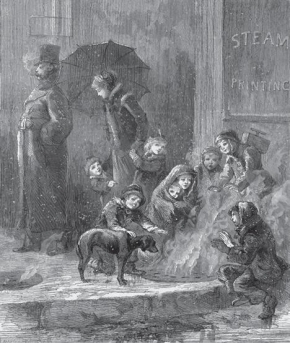
What did the creator of The Hearth-Stone of the Poor featured in Harper's Weekly most likely hope that viewers would notice about the wealthy couple in this illustration?
A) their stylish clothing
B) their indifference
C) their care for their own children
D) their proud bearing

Unlock Deck
Unlock for access to all 50 flashcards in this deck.
Unlock Deck
k this deck
44
What is one way that the American Federation of Labor (AFL) differed from the Knights of Labor?
A) The AFL excluded unskilled workers and African Americans from its membership.
B) The AFL disapproved of strikes.
C) The AFL had close ties with the Socialist Party.
D) The AFL advocated cooperation with industry.
A) The AFL excluded unskilled workers and African Americans from its membership.
B) The AFL disapproved of strikes.
C) The AFL had close ties with the Socialist Party.
D) The AFL advocated cooperation with industry.

Unlock Deck
Unlock for access to all 50 flashcards in this deck.
Unlock Deck
k this deck
45
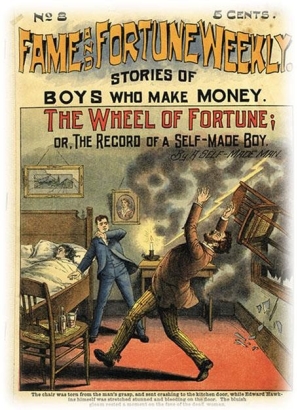
Books and magazines such as the one shown above focused on economic success stories about the self-made man, which had their origins with .
A) Herbert Spencer
B) Terence Powderly
C) Horatio Alger
D) Andrew Carnegie

Unlock Deck
Unlock for access to all 50 flashcards in this deck.
Unlock Deck
k this deck
46
Henry George's Progress and Poverty and Edward Bellamy's Looking Backward, 2000-1887 were both critical bestsellers with the American middle class of the 1880s because they each provided sharp critiques of industrialization and how it promoted .
A) environmental pollution
B) economic inequality
C) laissez-faire economics
D) harmony between the social classes
A) environmental pollution
B) economic inequality
C) laissez-faire economics
D) harmony between the social classes

Unlock Deck
Unlock for access to all 50 flashcards in this deck.
Unlock Deck
k this deck
47
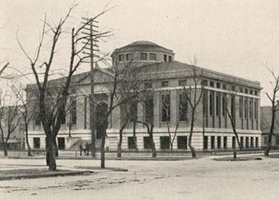
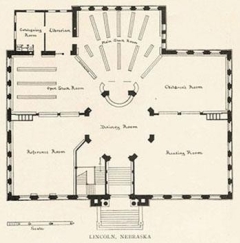
How do this Carnegie library in Lincoln, Nebraska, and its floor plans imitate Andrew Carnegie's values and beliefs?
A) The well-organized interior stressed the order and efficiency found in Carnegie's factories.
B) The exterior neoclassical design chosen by the public reflected Carnegie's desire to listen to his workers.
C) The librarian's desk in the corner symbolized the distance between workers and supervisor.
D) The plain external design served as a connection to Carnegie's humble beginnings.

Unlock Deck
Unlock for access to all 50 flashcards in this deck.
Unlock Deck
k this deck
48
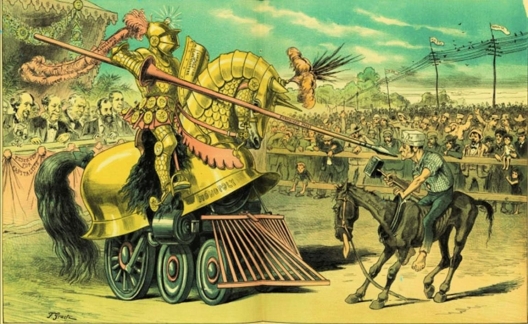
According to the cartoon The Tournament of Today-A Set-to Between Labor and Monopoly from Puck magazine, the only chance of success that a lowly worker had against large corporations was the use of , as symbolized by the mallet he is holding.
A) strikes
B) boycotts
C) riots
D) government regulations

Unlock Deck
Unlock for access to all 50 flashcards in this deck.
Unlock Deck
k this deck
49
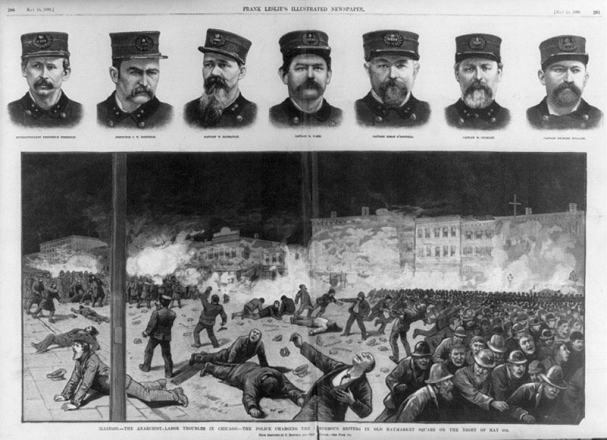
How did this image, which was featured in publications such as Frank Leslie's Illustrated Newspaper shortly after the Chicago Haymarket Riot of May 4, 1886, affect public opinion?
A) The public in general was more sensitive and sympathetic to workers in labor unions.
B) Many in the American public were now vehemently opposed to organized labor.
C) Workers across the nation ran for political office and were elected in great numbers.
D) Socialists and radicals became popular figures in American society.

Unlock Deck
Unlock for access to all 50 flashcards in this deck.
Unlock Deck
k this deck
50
When female workers at the Mundell Company in Philadelphia faced wage cuts like the ones that male workers at the company had successfully resisted, the workers opted to .
A) have the women strike while the men stayed on the job
B) refuse to strike to protect their jobs
C) have both the men and women strike together
D) cut off all negotiations with the company
A) have the women strike while the men stayed on the job
B) refuse to strike to protect their jobs
C) have both the men and women strike together
D) cut off all negotiations with the company

Unlock Deck
Unlock for access to all 50 flashcards in this deck.
Unlock Deck
k this deck



